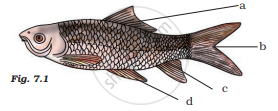Advertisements
Advertisements
प्रश्न
You are given leech, Nereis, Scolopendra, prawn and scorpion; and all have segmented body organisation. Will you classify them in one group? If no, give the important characters based on which you will separate these organisms into different groups.
उत्तर
No, we will not classify all the given organisms in one group because there are some characteristic features by which these organisms can be separated from each other and placed in two different group.
Leech and Nereis are placed in Phylum Annelida because:
- (i) Both of these have metamerically segmented body i.e. body is divided internally into many segments by septa. Body segments are lined up one after the other from head to tail.
- (ii) These animals have a closed circulatory system.
Scolopendra, Prawn, and scorpion are placed in Phylum Arthropoda because :- Their body is externally segmented and consists of the head thorax and abdomen.
- These animals have an open circulatory system and the coelomic cavity is blood-filled called hemocoel.
APPEARS IN
संबंधित प्रश्न
Name one example of the animal which shows the following characteristics:
Star-shaped body:
Observe the figure and answer the questions given below.
a) To which phylum these organisms belong?
b) Name the substance with which their body is covered.
c) Name their organs of locomotion.

Classify the following organisms based on the absence/presence of true coelom (i.e., acoelomate, pseudocoelomate and coelomate)
Spongilla, Sea anemone, Planaria, Liver fluke Wuchereria, Ascaris, Nereis, Earthworm, Scorpion, Birds, Fishes, Horse.
Label a,b,c and d. given in Fig. 7.1 Give the function of (b)

Write names of few thallophytes. Draw a labelled diagram of Spirogyra.
Paired and jointed legs are seen in phylum ______.
Name the three germ layers.
Which of the following ‘suffixes’ used for units of classification in plants indicates a taxonomic category of ‘family’?
Match the following and choose the correct option:
| Column I | Column II |
| A. Family | i. Tuberosum |
| B. Kingdom | ii. Polymoniales |
| C. Order | iii. Solanum |
| D. Species | iv. Plantae |
| E. Genus | v. Solanacea |
Define a taxon.
